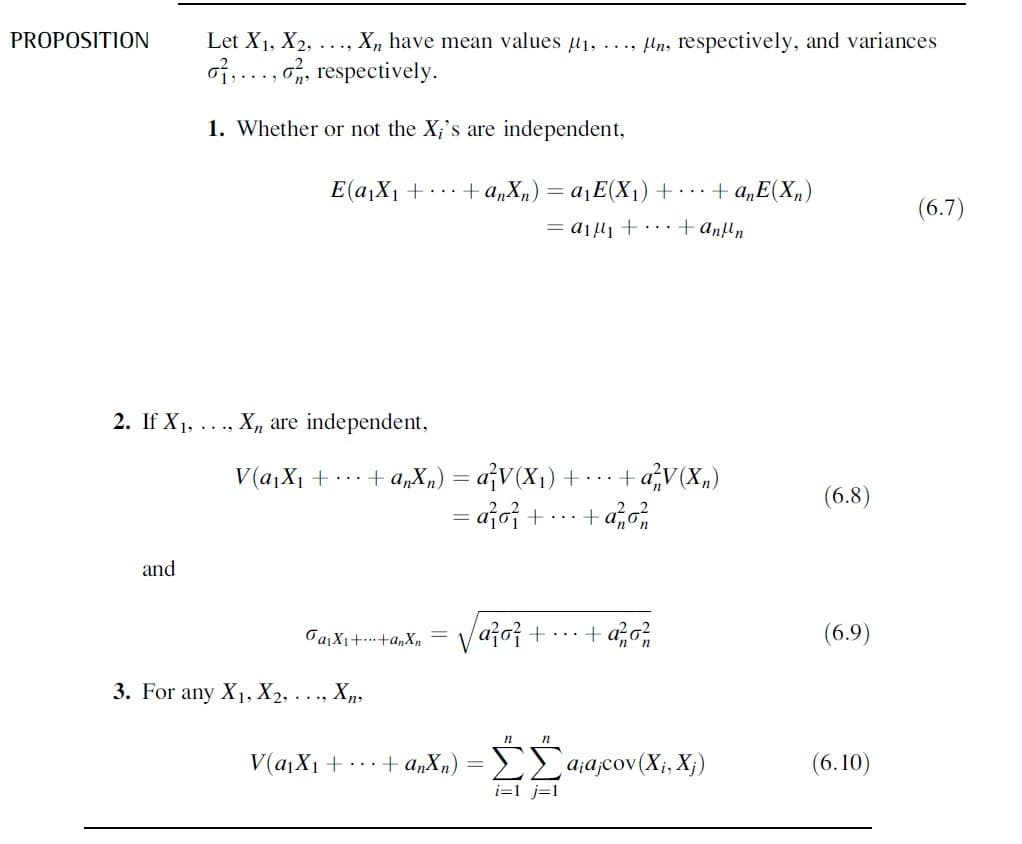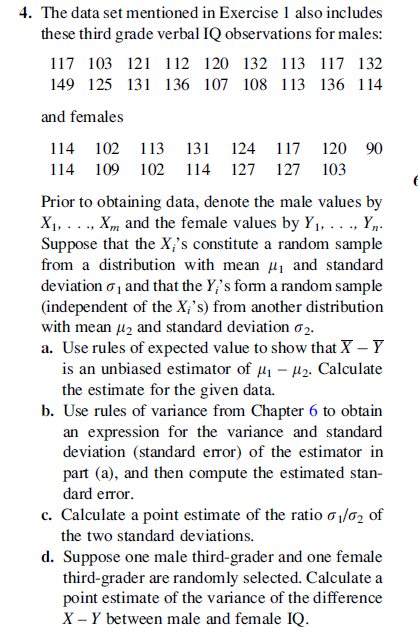4. The data set mentioned in Exercise 1 also includes these third grade verbal IQ observations for males: 117 103 121 112 120 132 113 117 132 149 125 131 136 107 108 113 136 114 and females 114 102 113 131 124 117 120 90 114 109 102 114 127 127 103 Prior to obtaining data, denote the male values by X1, ..., Xm and the female values by Y, .. ., Yµ. Suppose that the X;'s constitute a random sample from a distribution with mean u, and standard deviation o 1 and that the Y's form a random sample (independent of the X;'s) from another distribution with mean 42 and standard deviation o2. a. Use rules of expected value to show that X – Y is an unbiased estimator of µ1 – 42. Calculate the estimate for the given data. b. Use rules of variance from Chapter 6 to obtain an expression for the variance and standard deviation (standard error) of the estimator in part (a), and then compute the estimated stan- dard error. c. Calculate a point estimate of the ratio o1/02 of the two standard deviations. d. Suppose one male third-grader and one female third-grader are randomly selected. Calculate a point estimate of the variance of the difference X – Y between male and female IQ.
4. The data set mentioned in Exercise 1 also includes these third grade verbal IQ observations for males: 117 103 121 112 120 132 113 117 132 149 125 131 136 107 108 113 136 114 and females 114 102 113 131 124 117 120 90 114 109 102 114 127 127 103 Prior to obtaining data, denote the male values by X1, ..., Xm and the female values by Y, .. ., Yµ. Suppose that the X;'s constitute a random sample from a distribution with mean u, and standard deviation o 1 and that the Y's form a random sample (independent of the X;'s) from another distribution with mean 42 and standard deviation o2. a. Use rules of expected value to show that X – Y is an unbiased estimator of µ1 – 42. Calculate the estimate for the given data. b. Use rules of variance from Chapter 6 to obtain an expression for the variance and standard deviation (standard error) of the estimator in part (a), and then compute the estimated stan- dard error. c. Calculate a point estimate of the ratio o1/02 of the two standard deviations. d. Suppose one male third-grader and one female third-grader are randomly selected. Calculate a point estimate of the variance of the difference X – Y between male and female IQ.
MATLAB: An Introduction with Applications
6th Edition
ISBN:9781119256830
Author:Amos Gilat
Publisher:Amos Gilat
Chapter1: Starting With Matlab
Section: Chapter Questions
Problem 1P
Related questions
Concept explainers
Equations and Inequations
Equations and inequalities describe the relationship between two mathematical expressions.
Linear Functions
A linear function can just be a constant, or it can be the constant multiplied with the variable like x or y. If the variables are of the form, x2, x1/2 or y2 it is not linear. The exponent over the variables should always be 1.
Question
Could you solve part d please.
Thank you.

Transcribed Image Text:PROPOSITION
Let X1, X2, ..., X, have mean values µ1, ..., Un, respectively, and variances
of,..., o, respectively.
1. Whether or not the X;'s are independent,
E(a,X1 +...+ a„X„) = a¡E(X1)+·… + a„E(X„)
(6.7)
= ajli +. +anfln
2. If X1, ...,
, Xn are independent,
V(a,X1 +..+ anX„) = a¡V(X1)+
...+aV(X„)
(6.8)
= ajo;+
+ a,,
and
Važoj + · · ·+ azo?
(6.9)
3. For any X1, X2, . . ., Xn,
n
V(αι Χ + .+ α,X.) -ΣΣααcov (X, X)
(6.10)
i=1 j=1

Transcribed Image Text:4. The data set mentioned in Exercise 1 also includes
these third grade verbal IQ observations for males:
117 103 121 112 120 132 113 117 132
149 125 131 136 107 108 113 136 114
and females
114 102 113 131 124 117 120 90
114 109 102 114 127 127 103
Prior to obtaining data, denote the male values by
X1, ..., Xm and the female values by Y1, .. ., Y..
Suppose that the X;'s constitute a random sample
from a distribution with mean u1 and standard
deviation o and that the Y;'s fom a random sample
(independent of the X;'s) from another distribution
with mean µ2 and standard deviation o2.
a. Use rules of expected value to show that X – Y
is an unbiased estimator of µ1 – µ2. Calculate
the estimate for the given data.
b. Use rules of variance from Chapter 6 to obtain
an expression for the variance and standard
deviation (standard error) of the estimator in
part (a), and then compute the estimated stan-
dard error.
c. Calculate a point estimate of the ratio o1/02 of
the two standard deviations.
d. Suppose one male third-grader and one female
third-grader are randomly selected. Calculate a
point estimate of the variance of the difference
X – Y between male and female IQ.
Expert Solution
This question has been solved!
Explore an expertly crafted, step-by-step solution for a thorough understanding of key concepts.
This is a popular solution!
Trending now
This is a popular solution!
Step by step
Solved in 3 steps

Knowledge Booster
Learn more about
Need a deep-dive on the concept behind this application? Look no further. Learn more about this topic, statistics and related others by exploring similar questions and additional content below.Recommended textbooks for you

MATLAB: An Introduction with Applications
Statistics
ISBN:
9781119256830
Author:
Amos Gilat
Publisher:
John Wiley & Sons Inc

Probability and Statistics for Engineering and th…
Statistics
ISBN:
9781305251809
Author:
Jay L. Devore
Publisher:
Cengage Learning

Statistics for The Behavioral Sciences (MindTap C…
Statistics
ISBN:
9781305504912
Author:
Frederick J Gravetter, Larry B. Wallnau
Publisher:
Cengage Learning

MATLAB: An Introduction with Applications
Statistics
ISBN:
9781119256830
Author:
Amos Gilat
Publisher:
John Wiley & Sons Inc

Probability and Statistics for Engineering and th…
Statistics
ISBN:
9781305251809
Author:
Jay L. Devore
Publisher:
Cengage Learning

Statistics for The Behavioral Sciences (MindTap C…
Statistics
ISBN:
9781305504912
Author:
Frederick J Gravetter, Larry B. Wallnau
Publisher:
Cengage Learning

Elementary Statistics: Picturing the World (7th E…
Statistics
ISBN:
9780134683416
Author:
Ron Larson, Betsy Farber
Publisher:
PEARSON

The Basic Practice of Statistics
Statistics
ISBN:
9781319042578
Author:
David S. Moore, William I. Notz, Michael A. Fligner
Publisher:
W. H. Freeman

Introduction to the Practice of Statistics
Statistics
ISBN:
9781319013387
Author:
David S. Moore, George P. McCabe, Bruce A. Craig
Publisher:
W. H. Freeman